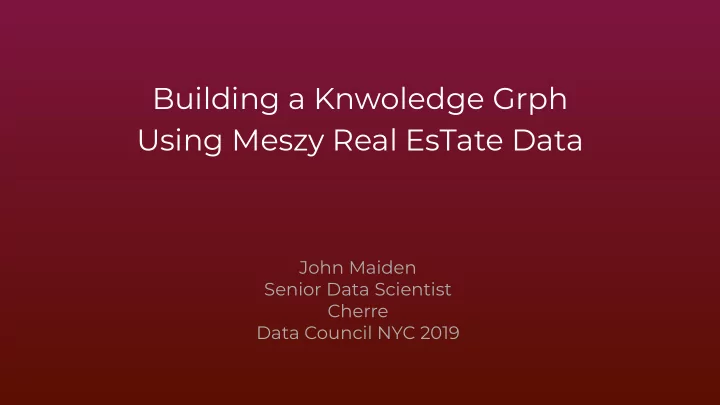

Building a Knwoledge Grph Using Meszy Real EsTate Data John Maiden Senior Data Scientist Cherre Data Council NYC 2019
What Is A Knowledge Graph? Google Search #1:
What Is A Knowledge Graph? Google Search #2: In computer science and information science, an ontology encompasses a representation, formal naming and definition of the categories, properties and relations between the concepts, data and entities that substantiate one, many or all domains of discourse. Every field creates ontologies to limit complexity and organize information into data and knowledge. As new ontologies are made, their use hopefully improves problem solving within that domain. Translating research papers within every field is a problem made easier when experts from different countries maintain a controlled vocabulary of jargon between each of their languages. [1] “Ontology (information science)”, Wikipedia, Retrieved October 26, 2019
Um, So What Is A Knowledge Graph? It is a graph (compared to a knowledge base) John Maiden Speaker (Location = NYC, Year = 2019, Track = Future of Data Science) ● Easier to visualize ● Relationships are a core component and can be analyzed / measured ● Straightforward to add new connections ● Traversable “WTF Is a Knowledge Graph”, Hackernoon, Retrieved October 26, 2019
What Questions Do We Want T o Answer? We want to use commercial real estate (CRE) data to answer questions like: ● Who is the property’s true owner? ● Which properties has this owner bought and sold in the past five years? ● Which lenders are seeing larger than average number of defaults?
What Questions Do We Want T o Answer? We want to use commercial real estate (CRE) data to answer questions like: ● Who is the property’s true owner? ● Which properties has this owner bought and sold in the past five years? ● Which lenders are seeing larger than average number of defaults? And eventually we want… ● Owner strategy - what types of properties do they buy? ● Models built from graph data (Comps, Valuation)
What Can We Do With A Knowledge Graph? What It Looks Like ● The NYC Graph alone has millions of edges and nodes! ● Nodes can be properties, people, corporations, or contact info.
What Can We Do With A Knowledge Graph? What We Want It To Look Like Corporations Property People
What Goes Into A CRE Knowledge Graph? https://az505806.vo.msecnd.net/cms/c31664b3-62ce-4b99-9414-de5f8130b27d/545a09fc-d0ba-48da-8237-3be6275eccc9.jpg
What Goes Into A CRE Knowledge Graph? Assessed taxes of $145k USD paid on Sold to ABC Corp by 4/18/19 by 123 Main DEF Corp on 1/23/12 St LLC Listed contact phone number on building permit as (111) 111-1111 Mortgage lender is Tenth National Owned by NYC Dept Bank of Transportation https://az505806.vo.msecnd.net/cms/c31664b3-62ce-4b99-9414-de5f8130b27d/545a09fc-d0ba-48da-8237-3be6275eccc9.jpg
NYC Open Data Sources
Translating This T o A Graph (NYC) Id: “123 Main St”, Id: “12345”, Type: “Address” Type: “BBL” Source: “PAD”, Date: “04/19/19” Id: “12345”, Id: “First Corp”, Type: “BBL” Type: “Lender” Source: “ACRIS”, Date: “01/23/12”
How Do We Join The Data? We have three different types of fuzzy join keys: ● People ○ “John Maiden” vs “Maiden, John W” vs “The Trust of JW Maiden” ● Corporations ○ “Main St LLC” vs “Main Street Advisors LLC” ● Addresses ○ “989 6th Ave” vs “989 Sixthe Ave” vs “989 Ave of Americas”
People / Corporation Standardization ● Names come in multiple formats ○ “John W Maiden” vs “Maiden, J” -> Person ● Categorization is important ○ “The Irrevocable Trust of John Maiden” -> “John Maiden” -> Person ○ “John Maiden LLC” -> Corporation ○ “John King” -> Person, “Burger King” -> Corporation ○ “Grant Herreman” vs “Grant Herrman” vs “GHSK” vs “Grant Herrman Schwartz & Klinger” -> Corporation / Lawyer / Service Provider ● Common Names ○ “John Smith”
People / Corporation Standardization How Do We Solve This? ● Regex (re.sub(r “.*TRUST.*”, “”, …)) ● NLP-based classification models (e.g. ngrams + XGBoost) ● Graph + Fuzzy Matching (word1, word2, fuzzy score = 89) ● Good Reference Data
Address Standardization ● Abbreviations / Alternate Names ○ “989 W 6th Ave” vs “989 West Sixth Avenue” vs “989 Avenue of the Americas” ● Spelling Variations ○ “Gouverneur St” vs “Governor St” ● Obvious Typos / Sticky Components ○ “989 6th St, NYC, NJ”, “123 MAIN STUNIT 7C” ● Embedded Addresses ○ “℅ John Maiden, 989 6th Ave, NYC, NY”
Address Standardization How Do We Solve This? ● Parse ● Standardize ● Match
Address Standardization - Parse A parser takes an input string and identifies it with its lexical information. "989 6TH AVE, FL 17, NYC, NY 10018" Word Tokenization (NLTK) [('989', 'CD'), ('6TH', 'CD'), ('AVE', 'NNP'), (',', ','), ('FL', 'NNP'), ('17', 'CD'), (',', ','), ('NYC', 'NNP'), (',', ','), ('NY', 'NNP'), ('10018', 'CD')] Address Tokenization (Cherre) [('989', 'AddressNumber'), ('6TH', 'StreetName'), ('AVE,', 'StreetNamePostType'), ('FL', 'OccupancyType'), ('17,', 'OccupancyIdentifier'), ('NYC,', 'PlaceName'), ('NY', 'StateName'), ('10018', 'ZipCode')]
Address Standardization - Standardize Standarize takes the parsed components and cleans / formats. Input 989 6TH AVE, FL 17, NYC, NY 10018 Output 989 SIXTH AVENUE FLOOR 17 NEW NY 10018 YORK
Address Standardization - Match Match takes the cleaned address and matches against an address database. ● SQL Join ○ “123 MAIN STREET, NEW YORK, NY 10001” -> “123 MAIN STREET, NEW YORK, NY 10001” ● SQL Join w/ Business Logic ○ “123 MAIN STREET APT 6C, NEW YORK, NY 10001” -> “123 MAIN STREET SUITE 6C, NEW YORK, NY 10001” ● Fuzzy Join ○ “ 124 MAIN AVENUE , NEW YORK, NY, 10001” -> “ 123 MAIN STREET , NEW YORK, NY 10001”
Address Standardization - T echnology ● Parse ○ Regex 😓 , Hidden Markov Models, Conditional Random Fields, Neural Network ● Standardize ○ Regex, Lookup Tables ● Match ○ SQL Join, User Defined Aggregation Functions, Fuzzy Join (e.g. Hashing)
Standardization - Lessons Learned ● Business Knowledge / Context is Critical ○ Understand your data! ○ Humans are useful! ● Learn to Deal with Scale ○ Standardizing millions of addresses Live with Ambiguity 🤸 ●
Recommend
More recommend